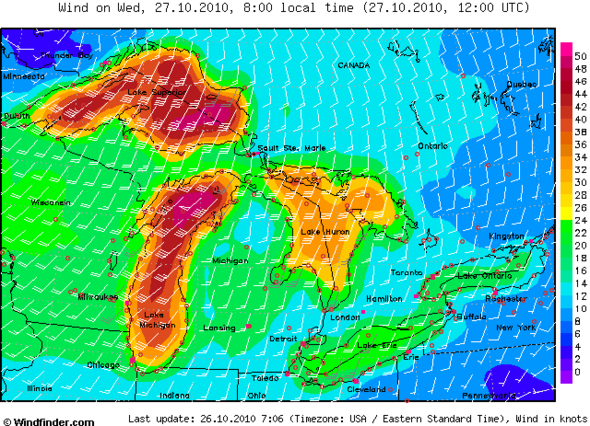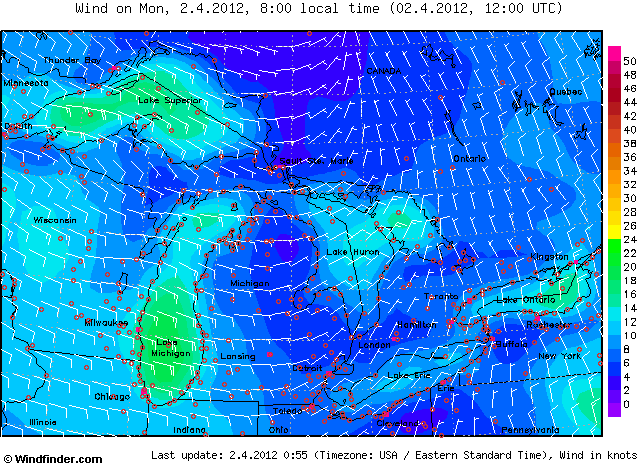Obama Admin and Great Lakes Wind
April 2nd, 2012
Note this is an old map – I pulled it up at the Windfinder site and this is what it looks like today:
Anyway, the news from Friday is that the Obama Administration and some, but NOT all, of the Great Lakes States signed a Memorandum of Understanding, oh, also many federal agencies, like U.S. Fish & Wildlife.
I think this is an important step. Lake Superior is too deep, but Lake Michigan and Lake Erie are the ones I’ve heard most often discussed as having high potential, and what’s particularly good about it is that they’re right near load centers. Offshore would remove the “too close to neighbors” health concerns that are a significant issue. But as with the Delaware Bluewater project, the environmental work needs to be done, and I hope it’s done more thoroughly than for on-shore wind. What are infrasound impacts on marine life? I’d asked Rick James, I.N.C.E., about this when he was here a couple years ago, and he hadn’t heard of any research on this point. Hmmmmmm… big gap.
So there’s a start… An interesting one is “The effects of human-generated sound on fish” which among other thing notes that it’s been suggested that birds use infrasound for migration, the waves bouncing of geological features!
Anyway, here’s the Memorandum of Understanding:
Great Lakes Offshore Wind Energy Consortium Memorandum of Understanding
And the Press Release:
Note that Wisconsin did NOT sign, which is consistent with WPPI’s testimony in the CapX 2020 Hampton-Rochester-LaCrosse docket that they want to get their RPS wind from outside WI, despite the fact that the model assumptions include an estimated 103,757 MW of wind generation potential at or above 30% capacity and 20,741 MW at or above 35% capacity, not including any Lake Michigan development. Despite this potential in Wisconsin, his testimony was that he had his heart set on getting their RPS from west of Wisconsin! His own Burns & McDonnell study, Exhibit 2, said:
If our understanding of current transmission planning results is correct, it is generally more expensive (than this breakeven indication) to build additional power transfer capability over such a long distance. There may be other reasons that could justify such a build0out, but capacity factor differential alone does not.
Well DUH!
Here’s his testimony and Exhibits, worth a look:
Noeldner WPPI Direct Testimony
Noeldner – Exhibit 2 – Wind Economics Study & Model Produced for WPPI Energy
Noeldner – Exhibit 3 – Wind Assessment Model Results (see fn. 6)
They’ve got it exactly backwards
July 20th, 2009
Remember “Think Globally, Act Locally” — the bumper sticker and the practice?
Now we’ve got the wind industry winding people up to do just the opposite! This is a study released recently, looking to power the world on Midwest wind:
They’re assuming land turbines at 2.5 MW which is nearly twice the size of typical land turbines. They’re also saying that this could be done with turbines running even at a 20% capacity factor, which I do think makes sense. But that makes sense when it’s near load, doesn’t make any sense when long transmission lines, with lots of transmission losses. So powering the world by this limited geographic area does not make sense.


